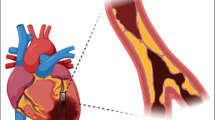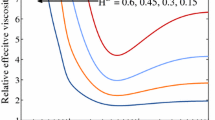Abstract
The regulation of the coronary circulation is a complex paradigm in which many inputs that influence vasomotor tone have to be integrated to provide the coronary vasomotor adjustments to cardiac metabolism and to perfusion pressure. We hypothesized that the integration of many disparate signals that influence membrane potential of smooth muscle cells, calcium sensitivity of contractile filaments, receptor trafficking result in complex non-linear characteristics of coronary vasomotion. To test this hypothesis, we measured an index of vasomotion, flowmotion, the periodic fluctuations of flow that reflect dynamic changes in resistances in the microcirculation. Flowmotion was continuously measured in periods ranging from 15 to 40 min under baseline conditions, during antagonism of NO synthesis, and during combined purinergic and NOS antagonism in the beating heart of anesthetized open-chest dogs. Flowmotion was measured in arterioles ranging from 80 to 135 μm in diameter. The signals from the flowmotion measurements were used to derive quantitative indices of non-linear behavior: power spectra, chaotic attractors, correlation dimensions, and the sum of the Lyapunov exponents (Kolmogorov–Sinai entropy), which reflects the total chaos and unpredictability of flowmotion. Under basal conditions, the coronary circulation demonstrated chaotic non-linear behavior with a power spectra showing three principal frequencies in flowmotion. Blockade of nitric oxide synthase or antagonism of purinergic receptors did not affect the correlation dimensions, but significantly increased the Kolmogorov–Sinai entropy, altered the power spectra of flowmotion, and changed the nature of the chaotic attractor. These changes are consistent with the view that certain endogenous controls, nitric oxide and various purines (AMP, ADP, ATP, adenosine) make the coronary circulation more predictable, and that blockade of these controls makes the control of flow less predictable and more chaotic.



Similar content being viewed by others
References
Albano AM, Muench J, Schwartz C, Mees AI, Rapp PE (1988) Singular-value decomposition and the Grassberger–Procaccia algorithm. Phys Rev A 38:3017
Angello DA, Headrick JP, Coddington NM, Berne RM (1990) Adenosine antagonism decreases metabolic but not functional recovery from ischemia. Am J Physiol Heart Circ Physiol 260:H193–H200
Bache RJ, Dai X, Schwartz JS, Homans DC (1988) Role of adenosine in coronary vasodilation during exercise. Circ Res 62:846–853
Barclay KD, Klassen GA, Young C (2000) A method for detecting chaos in canine myocardial microcirculatory red cell flux. Microcirculation 7:335–346
Berne RM (1980) The role of adenosine in the regulation of coronary blood flow. Circ Res 47:807–813
Broomhead DS, King GP (1986) Extracting qualitative dynamics from experimental data. Phys D 20:217–236
Bryant P, Brown R, Abarbanel HDI (1990) Lyapunov exponents from observed time series. PhysRev Lett 65:1523
Chilian WM, Eastham CL, Marcus ML (1986) Microvascular distribution of coronary vascular resistance in beating left ventricle. Am J Physiol 251:H779–H788
Chilian WM, Layne SM, Eastham CL, Marcus ML (1989) Heterogeneous microvascular coronary α-adrenergic vasoconstriction. Circ Res 64:376–388
Cornelissen AJM, Dankelman J, VanBavel E, Spaan JAE (2002) Balance between myogenic, flow-dependent, and metabolic flow control in coronary arterial tree: a model study. Am J Physiol Heart Circ Physiol 282:H2224–2237
Crutchfield JP, Farmer JD, Packard NH, Shaw RS (1986) Chaos. Sci Am 255:46–57
Dankelman J, Spaan JAE, Van der Ploeg CPB, Vergroesen I (1989) Dynamic response of the coronary circulation to a rapid change in its perfusion in the anaesthetized goat. J Physiol 419:703–715
Dankelman J, Vergroesen I, Han Y, Spaan JAE (1992) Dynamic response of coronary regulation to heart rate and perfusion changes in dogs. Am J Physiol 263:H447–H452
DeFily DV, Patterson JL, Chilian WM (1995) Endogenous adenosine modulates alpha 2- but not alpha 1-adrenergic constriction of coronary arterioles. Am J Physiol 268:H2487–2494
Drake-Holland AJ, Laird JD, Noble MI, Spaan JA, Vergroesen I (1984) Oxygen and coronary vascular resistance during autoregulation and metabolic vasodilation in the dog. J Physiol 348:285–299
Duncker DJ, Van Zon NS, Altman JD, Pavek TJ, Bache RJ (1993) Role of K+ATP channels in coronary vasodilation during exercise. Circulation 88:1245–1253
Dundore RL, Pratt PF, O’Connor B, Buchholz RA, Pagani ED (1991) Nomega-nitro-l-arginine attenuates the accumulation of aortic cyclic GMP and the hypotension produced by zaprinast. Eur J Pharmacol 200:83–87
Gold ME, Wood KS, Byrns RE, Buga GM, Ignarro LJ (1990) l-Arginine-dependent vascular smooth muscle relaxation and cGMP formation. Am J Physiol Heart Circ Physiol 259:H1813–H1821
Gräser T, Vanhoutte PM (1991) Hypoxic contraction of canine coronary arteries: role of endothelium and cGMP. Am J Physiol Heart Circ Physiol 261:H1769–H1777
Griffith TM (1996) Temporal chaos in the microcirculation. Cardiovasc Res 31:342–358
Griffith TM, Edwards DH (1995) Complexity of chaotic vasomotion is insensitive to flow and pressure but can be regulated by external control. Am J Physiol 269:H656–668
Griffith TM, Edwards DH (1993) Mechanisms underlying chaotic vasomotion in isolated resistance arteries: roles of calcium and EDRF. Biorheology 30:333–347
Hastings A, Hom CL, Ellner S, Turchin P, Godfray HC (1993) Chaos in ecology: is mother nature a strange attractor? Ann Rev Ecol Syst 24:1–33
Haynes J Jr, Robinson J, Saunders L, Taylor AE, Strada SJ (1992) Role of cAMP-dependent protein kinase in cAMP-mediated vasodilation. Am J Physiol Heart Circ Physiol 262:H511–H516
Hein TW, Kuo L (1999) cAMP-independent dilation of coronary arterioles to adenosine: role of nitric oxide, G proteins, and KATP channels. Circ Res 85:634–642
Hentschel HGE, Procaccia I (1983) Fractal nature of turbulence as manifested in turbulent diffusion. Phys Rev A 27:1266
Herrmann SC, Feigl EO (1992) Adrenergic blockade blunts adneosine concentration and coronary vasodilation during hypoxia. Circ Res 70:1203–1216
Ignarro LJ (1990) Biosynthesis and metabolism of endothelium-derived nitric oxide. Annu Rev Pharmacol Toxicol 30:535–560
James T, Stephen E, Andr, Longtin, Bryan G, Farmer JD (1992) Testing for nonlinearity in time series: the method of surrogate data. In: Conference proceedings on interpretation of time series from nonlinear mechanical systems. Elsevier North-Holland, Warwick
Jones CJH, Kuo L, Davis MJ, Chilian WM, DeFily DV (1995) Role of nitric oxide in the coronary microvascular responses to adenosine and increased metabolic demand. Circulaiton 91:1807–1813
Kleinbaum DG, Kupper LL, Muller KE (1988) Duxbury Press, Belmont
Kleppisch T, Nelson MT (1995) Adenosine activates ATP-sensitive potassium channels in arterial myocytes via A2 receptors and cAMP-dependent protein kinase. Proc Natl Acad Sci USA 92:12441–12445
Liau B-Y, Yeh S-J, Chiu C-C, Tsai C (2008) Dynamic cerebral autoregulation assessement using chaotic analysis in diabetic autonomic neuropathy. Med Biol Eng Comput 46:1–9
Miyashiro JK, Feigl EO (1995) A model of combined feedforward and feedback control of coronary blood flow. Am J Physiol 268:H895–908
Packard NH, Crutchfield JP, Farmer JD, Shaw RS (1980) Geometry from a time series. Phys Rev Lett 45:712
Parlitz U (1991) Identification of true and spurious Lyapunov exponents from time series. Int J Bifurc Chaos 2:155–165
Parthimos D, Edwards DH, Griffith TM (1999) Minimal model of arterial chaos generated by coupled intracellular and membrane Ca2+ oscillators. Am J Physiol 277:H1119–1144
Parthimos D, Edwards DH, Griffith TM (2003) Shil’nikov homoclinic chaos is intimately related to type-III intermittency in isolated rabbit arteries: role of nitric oxide. Phys Rev E Stat Nonlin Soft Matt Phys 67:051922
Parthimos D, Edwards DH, Griffith TM (2001) Universal scaling properties of type-I intermittent chaos in isolated resistance arteries are unaffected by endogenous nitric oxide synthesis. Phys Rev E Stat Nonlin Soft Matter Phys 64:061906
Richmond KN, Tune JD, Gorman MW, Feigl EO (1999) Role of K+ATP channels in local metabolic coronary vasodilation. Am J Physiol 277:H2115–2123
Rubio R, Wiedmeier VT, Berne RM (1974) Relationship between coronary flow and adenosine production and release. J Mol Cell Cardiol 6:561–566
Sauer T (1994) Reconstruction of dynamical systems from interspike intervals. Phys Rev Lett 72:3811
Sauer T, Yorke JA, Casdagli M (1991) Embedology. J Stat Phy 65:579–616
Shannon C, Weaver H (1949) The mathematical theory of communication. University of Illinois Press, Urbana
Stamatis N, Parthimos D, Griffith TM (1996) Prediction of arterial “burst” activity and transitions between chaotic attractors with a multilayer perceptron optimized by a new stopping criterion. Int J Neural Syst 7:417–428
Stepp DW, Van Bibber R, Kroll K, Feigl EO (1996) Quantitative relation between interstitial adenosine concentration and coronary blood flow. Circ Res 79:601–610
Sugihara G, May RM (1990) Nonlinear forecasting as a way of distinguishing chaos from measurement error in time series. Nature 344:734–741
Takens F (1981) Detecting strange attractors in turbulence. Lect Notes Math 898:366–381
Tune JD, Gorman MW, Feigl EO (2004) Matching coronary blood flow to myocardial oxygen consumption. J Appl Physiol 97:404–415
Tune JD, Richmond KN, Gorman MW, Feigl EO (2000) Role of nitric oxide and adenosine in control of coronary blood flow in exercising dogs. Circulation 101:2942–2948
Tune JD, Richmond KN, Gorman MW, Olsson RA, Feigl EO (2000) Adenosine is not responsible for local metabolic control of coronary blood flow in dogs during exercise. Am J Physiol Heart Circ Physiol 278:H74–H84
Van Bibber R, Stepp DW, Kroll K, Feigl EO (1997) Role of adenosine in norepinephrine-induced coronary vasodilation. Am J Physiol 273:H557–H565
Wales D (1991) Calculating the rate of loss of information from chaotic time series by forecasting. Nature 350:485–488
Yada T, Hiramatsu O, Tachibana H, Toyota E, Kajiya F (1999) Role of NO and KATP channels in adenosine-induced vasodilation on in vivo canine subendocardial arterioles. Am J Physiol 277:H1931–H1939
Acknowldgments
The authors wish to thank Dr. David Defily for his invaluable contributions and Dr. Jennifer Taylor for her assistance with the data analysis.
Author information
Authors and Affiliations
Corresponding author
Additional information
Supported by NIH grant HL32788.
Rights and permissions
About this article
Cite this article
Trzeciakowski, J., Chilian, W.M. Chaotic behavior of the coronary circulation. Med Biol Eng Comput 46, 433–442 (2008). https://doi.org/10.1007/s11517-008-0329-8
Received:
Accepted:
Published:
Issue Date:
DOI: https://doi.org/10.1007/s11517-008-0329-8




